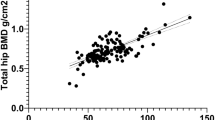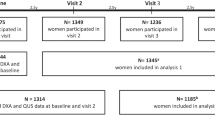Abstract
The aim of this study was to determine whether calcaneal quantitative ultrasound can discriminate between women with and those without fragility fracture at (1) the wrist or (2) at sites other than the spine, hip, or forearm, as well as axial DXA measurements of BMD can. The study population consisted of 342 postmenopausal Caucasian women who were placed into one of three groups: (1) healthy women with no clinical risk factors for osteoporosis (n = 240); (2) women with a history of atraumatic fracture at the wrist (n = 50); (3) women with a history of atraumatic fracture at a skeletal site other than the spine, hip, or wrist (n = 52). Subjects had DXA measurements of the lumbar spine (LS), femoral neck (FN), and total hip (THIP), and calcaneal broadband ultrasound attenuation (BUA) and speed of sound (SOS) measurements on the Hologic Sahara (s) and Osteometer DTUone (d). Z-scores were calculated using the mean and SD obtained from the healthy postmenopausal group. All the BMD and QUS variables were significantly reduced in women reporting a fracture of the wrist or at a site other than the spine, hip, or forearm. When the group of women with a history of wrist fracture were compared with the postmenopausal controls, age-adjusted logistic regression yielded odds ratios associated with a 1 SD decrease, that were significant for both BMD and QUS, averaging 2.2. The AUC values ranged from 0.65 for FN BMD to 0.75 for BUAd. BMD and QUS measurements were also significantly reduced in women reporting a skeletal fracture at a site other than the spine, hip, or wrist, and odds ratios for BMD and QUS were significant, averaging 1.7. BMD and QUS showed similar fracture discriminatory abilities that were not significantly different from one another. In conclusion, calcaneal QUS can discriminate between women with and those without fracture at the wrist or at sites other than the spine, hip, or forearm as well as axial DXA measurements of BMD can.
Similar content being viewed by others
Author information
Authors and Affiliations
Rights and permissions
About this article
Cite this article
Frost, M., Blake, G. & Fogelman, I. A comparison of fracture discrimination using calcaneal quantitative ultrasound and dual X-ray absorptiometry in women with a history of fracture at sites other than the spine and hip . Calcif Tissue Int 71, 207–211 (2002). https://doi.org/10.1007/s00223-001-2074-y
Received:
Accepted:
Issue Date:
DOI: https://doi.org/10.1007/s00223-001-2074-y




